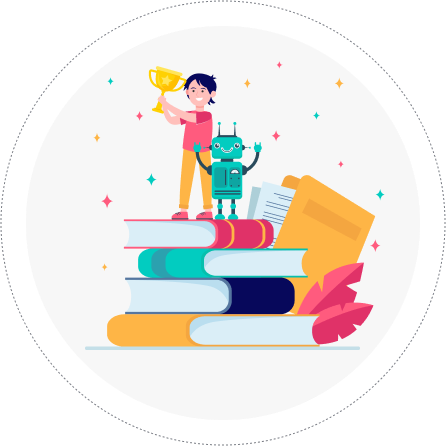Artificial Intelligence 12
- Home
- / Python Handay
- / Artificial Intelligence 12
Welcome!
This Web Designing course aims to provide students with the fundamental skills and knowledge required to create visually appealing, user-friendly websites. The course covers both the theoretical and practical aspects of web design, focusing on industry-standard tools and techniques.
Prerequisites
- Basic computer skills
- Familiarity with the internet and web browsing
- Interest in learning about web design
Learning Objectives
- Understand the fundamentals of web design and development
- Create responsive and visually appealing websites using HTML, CSS, and JavaScript
- Implement best practices for user experience (UX) and user interface (UI) design
- Use web design tools such as Adobe XD, Figma, or Sketch
- Optimize websites for search engines (SEO) and performance
- Deploy websites on web hosting platforms
Course Overview
- Introduction to Web Design
- Overview of web design and its importance
- Differences between web design and web development
- Understanding the web design process
- HTML (Hypertext Markup Language)
- Basics of HTML: Elements, Tags, and Attributes
- Structure of an HTML document
- Creating forms, tables, and lists
- Semantic HTML for better SEO
- CSS (Cascading Style Sheets)
- Introduction to CSS: Selectors, Properties, and Values
- Styling text, colors, and backgrounds
- Box model and layout techniques (margin, padding, border)
- Flexbox and CSS Grid for responsive design
- Media queries for mobile-first design
- JavaScript Basics
- Introduction to JavaScript: Syntax and Variables
- Data types and Operators
- Functions, Events, and DOM Manipulation
- Creating interactive web elements
- User Experience (UX) Design
- Principles of UX design
- Understanding user research and personas
- Creating user journeys and wireframes
- Prototyping and usability testing
- User Interface (UI) Design
- Basics of UI design and its principles
- Color theory, typography, and visual hierarchy
- Creating design systems and style guides
- Tools for UI design (Adobe XD, Figma, etc.)
- Responsive Web Design
- Importance of responsive design
- Techniques for creating responsive layouts
- Implementing mobile-first design principles
- Testing websites on different devices and browsers
- Web Design Tools and Software
- Overview of design software: Adobe Photoshop, Adobe XD, Figma, Sketch
- Introduction to version control systems (Git)
- Using CSS preprocessors like SASS or LESS
- Search Engine Optimization (SEO) Basics
- Understanding SEO and its importance for web design
- On-page SEO techniques: Title tags, meta descriptions, and keywords
- Best practices for optimizing images and content
- Web Hosting and Deployment
- Understanding web hosting and domain names
- Deploying websites using platforms like GitHub Pages, Netlify, or Vercel
- Basics of FTP and file management
- Final Project
- Designing and developing a complete website
- Applying learned skills in a real-world project
- Presenting the project to peers and instructors
Enquiry Now
Our Courses
Data Analyst using Python
Select Tech MindGuru for Why ?
Placement Assistance
Placement assistance offered for a successful career.
Membership
Membership provided until the final examination.
Personalized Attention
Personalized attention provided to each student.

Get Course Certificate
Certificate awarded upon completion of the course.
Monthly Tests
Regular monthly test series for progress evaluation.
Latest CBSE Syllabus
Training modules aligned with the latest CBSE syllabus.
Frequently Asked Questions
The course typically lasts 6-8 weeks, depending on the learning pace and schedule.
Basic computer skills and familiarity with the internet are helpful, but no prior coding knowledge is necessary.
Graduates can pursue roles such as Web Designer, UI/UX Designer, Front-End Developer, or work as freelance designers.
You’ll learn to use HTML, CSS, JavaScript, and design tools like Adobe XD, Figma, or Sketch.
Entry-level web designers can earn between ₹2.5 to ₹5 lakhs per year in India, depending on location and skills.
With increasing demand for user-friendly, responsive websites, the future of web design is highly promising, especially with advancements in UX/UI design and mobile-first development.


